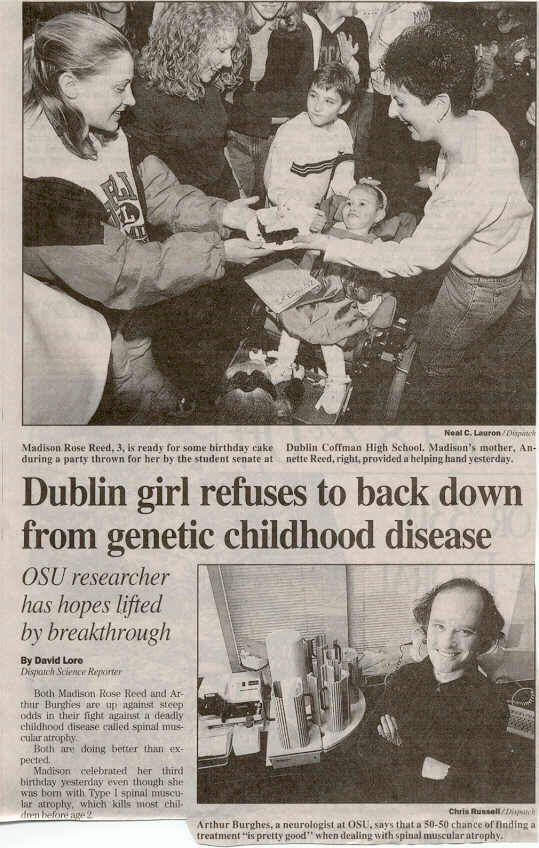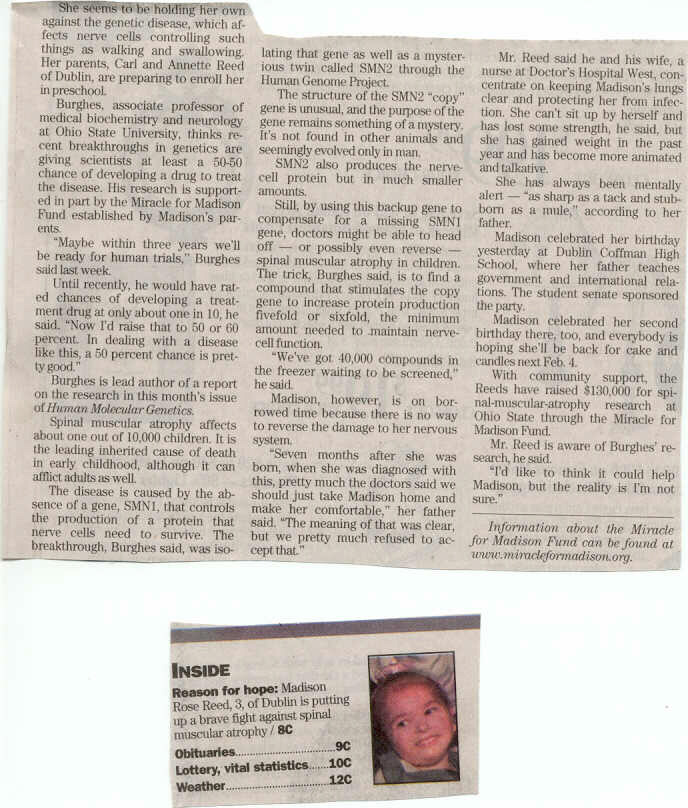

![]()
Both Madison Rose Reed and Arthur Burghes are up against steep odds in their
fight against a deadly childhood disease called spinal muscular atrophy.
Both are doing better than expected.
Madison celebrated her third birthday yesterday even though she was born with Type I spinal muscular atrophy, which kills most children before age 2.
She seems to be holding her own against the genetic disease, which affects nerve cells controlling such things as walking and swallowing. Her parents, Carl and Annette Reed of Dublin, are preparing to enroll her in preschool.
Burghes, associate professor of medical biochemistry and neurology at Ohio State University, thinks recent breakthroughs in genetics are giving scientists at least a 50-50 chance of developing a drug to treat the disease. His research is supported in part by the Miracle for Madison Fund established by Madison's parents.
"Maybe within three years we'll be ready for human trials,'' Burghes said last week.
Until recently, he would have rated chances of developing a treatment drug at only about one in 10, he said. "Now I'd raise that to 50 or 60 percent. In dealing with a disease like this, a 50 percent chance is pretty good.''
Burghes is lead author of a report on the research in this month's issue of Human Molecular Genetics.
Spinal muscular atrophy affects about one out of 10,000 children. It is the leading inherited cause of death in early childhood, although it can afflict adults as well.
The disease is caused by the absence of a gene, SMN1, that controls the production of a protein that nerve cells need to survive. The breakthrough, Burghes said, was isolating that gene as well as a mysterious twin called SMN2 through the Human Genome Project.
The structure of the SMN2 "copy'' gene is unusual, and the purpose of the gene remains something of a mystery. It's not found in other animals and seemingly evolved only in man.
SMN2 also produces the nerve- cell protein but in much smaller amounts.
Still, by using this backup gene to compensate for a missing SMN1 gene, doctors might be able to head off -- or possibly even reverse -- spinal muscular atrophy in children. The trick, Burghes said, is to find a compound that stimulates the copy gene to increase protein production fivefold or sixfold, the minimum amount needed to maintain nerve- cell function.
"We've got 40,000 compounds in the freezer waiting to be screened,'' he said.
Madison, however, is on borrowed time because there is no way to reverse the damage to her nervous system.
"Seven months after she was born, when she was diagnosed with this, pretty much the doctors said we should just take Madison home and make her comfortable,'' her father said. "The meaning of that was clear, but we pretty much refused to accept that.''
Mr. Reed said he and his wife, a nurse at Doctor's Hospital West, concentrate on keeping Madison's lungs clear and protecting her from infection. She can't sit up by herself and has lost some strength, he said, but she has gained weight in the past year and has become more animated and talkative.
She has always been mentally alert -- "as sharp as a tack and stubborn as a mule,'' according to her father.
Madison celebrated her birthday yesterday at Dublin Coffman High School, where her father teaches government and international relations. The student senate sponsored the party.
Madison celebrated her second birthday there, too, and everybody is hoping she'll be back for cake and candles next Feb. 4.
With community support, the Reeds have raised $130,000 for spinal-muscular-atrophy research at Ohio State through the Miracle for Madison Fund.
Mr. Reed is aware of Burghes' research, he said.
"I'd like to think it could help Madison, but the reality is I'm not sure.''
Information about the Miracle for Madison Fund can be found at www.miracleformadison.org.
Caption: (1) Neal C. Lauron / Dispatch
Madison Rose Reed, 3, is ready for some birthday cake during a party thrown for
her by the student senate at Dublin Coffman High School. Madison's mother,
Annette Reed, right, provided a helping hand yesterday.
(2) Chris Russell / Dispatch
Arthur Burghes, a neurologist at OSU, says that a 50-50 chance of finding a
treatment "is pretty good'' when dealing with spinal muscular atrophy.
Tressel Continues OSU Involvement with Fund-raising for Madison Reed
Part of Ticket Money from Saturday's
spring game went to the charity
by Brian Richesson
Vindicator Sports Staff
Columbus-Coach Jim Tressel and the Ohio State football team have strengthened their bond with the Miracle for Madison fund.
When she was 7 months old, Madison Rose Reed was diagnosed with Spinal Muscular Atrophy (SMA) Type 1.
But Madison, the daughter of 1978 Ursuline High graduate, the former Annette Worrellia, is 4 years old and has already lived two years past what is expected of Type 1 cases.
Hope is reigning strong for the family that resides in Dublin.
Good Morning: "Madison is very high maintenance, but she wakes up with a smile on her face," said Carl Reed, Annette's husband and Madison's father.
SMA is a group of inherited diseases that destroy motor neurons controlling voluntary movements such as crawling, walking, head and neck control and swallowing.
Through Madison's fund, Annette and Carl have been working to raise money to fund research for the disease and an eventual cure.
Now, Tressel has become part of the crusade, which Ohio State football players and coaches have been involved with in the past.
"I talked to Coach about getting involved, not so much about bringing in a lot of money, but to keep that connection between the football program and what we're trying to accomplish every year," Carl said.
Tressel, along with his players and coaches, were guests at the third annual fund-raising event for Madison held March 10 at the Buckeye Hall of Fame Cafe.
In addition, money from the 20,000 tickets sold for Saturday's Scarlet and Gray Game at Crew Stadium benefited Madison's fund, which is approaching $300,000, Carl said.
By donating 50 cents from each ticket sold, the Ohio State athletic department hoped to provide $10,000.
Another cause: Ohio State is also contributing the same amount to a fund for Stefanie Spielman, wife of former Ohio State football player Chris Spielman.
Mrs. Spielman is battling breast cancer.
"Hopefully, someday these two diseases will be wiped out," Tressel said, "But until they are, they need our support."
To learn more about Madison and SMA, visit www.miracleformadison.org.
Sky Chemicals, "What's New", August 1999
 Sometimes
with our focus on sales and bottom lines, we forget that there are people at the
end of the sales chain. With respect to creatine sales, it's more than that. The
image is of the body builders and football players, but there is another group
that need and use creatine, but they don't get their pictures in the newspapers
and magazines. The picture of the little girl is a case in point. Her name is
Madison Reed, she is two years old, and has spinal muscular atrophy (SMA).
Madison was diagnosed with this disease when she was 5 months old. She has been
battling ever since, trying to stay alive while doctors search for a cure.
Sometimes
with our focus on sales and bottom lines, we forget that there are people at the
end of the sales chain. With respect to creatine sales, it's more than that. The
image is of the body builders and football players, but there is another group
that need and use creatine, but they don't get their pictures in the newspapers
and magazines. The picture of the little girl is a case in point. Her name is
Madison Reed, she is two years old, and has spinal muscular atrophy (SMA).
Madison was diagnosed with this disease when she was 5 months old. She has been
battling ever since, trying to stay alive while doctors search for a cure.
Madison, along with many others who are afflicted by neuromuscular disorders, is continually losing strength and muscle control due to the disease. Creatine is helping her and people like her to have a better quality of life while science seeks a cure. Patients of muscular dystrophy, ALS (Lou Gerhig's Disease) and Parkinson's have been shown to respond favorably to the addition of creatine as a supplement to their diets. Although the creatine does not have an effect on the disease, it is able to help maintain and in come cases improve muscle strength and control.
SKW is supporting on going clinical trials in the U.S. for these diseases by providing their product, Creapure. Madison's doctors are conducting a clinical trial with SMA patients using SKW's Creapure at Ohio State University in cooperation with the Children's Hospital. This 2-year trial hopes to discover if the addition of creatine to their diets can improve the quality of life for these patients. The Muscular Dystrophy Association is conducting trials at several sites with creatine as is John Hopkins University. The use of creatine supplementation for these and other diseases is now being studied in ever increasing numbers, as its potential application expands. SKW supports this work with product and scientific expertise. So, take a look at Madison's picture, we thought you'd like to see one of the faces on the "bottom line".
![]()